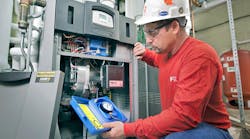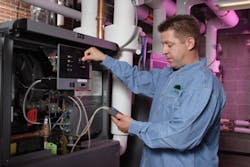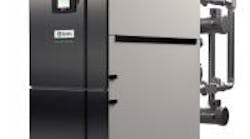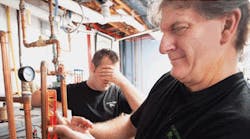Gas boilers are a durable and reliable heating source. Old-style atmospheric gas boilers could go a long time without regular maintenance. But many of the new, higher efficiency, modulating-condensing boilers and some of the heating system components that interact with them require a bit more care to maintain peak performance.
Troubles in the mechanical room will quickly affect other parts of the building, overall customer happiness (or lack of it), and, in turn, your ability to sleep at night. With that in mind, here are the crucial preventive maintenance (PM) steps to ensure proper boiler performance.
Start With the Maintenance Log
Many boiler problems stem from mistakes made during installation, so the first order of business in establishing a preventive maintenance schedule is to assess the overall picture. Look closely and record in the maintenance log what you see in the system piping, venting, gas or oil supply, and all other key facets of the mechanical room.
The boiler start-up sheet can and should be used to evaluate system performance and to spot trends that affect the boiler’s operating pressure (for a steam boiler), operating temperature (for hot water systems), stack temperature, and water-level controls.
Completion of a maintenance log not only records the basic situation as you see it today, it also sets a baseline for later maintenance and service calls, whether they’re routine, or generated by a no-heat call. In the field, we quickly learn that one problem could have many possible causes. Keeping a detailed record of the “forensics” makes sense, doesn’t it? Yet the trail of information is too often neglected, lengthening the time it may take you to do the diagnostics. Basic record-keeping is essential.
The Key PM Categories
Key categories for routine boiler maintenance include:
• Venting
• Combustion air
• Gas or oil supply piping and filtration
• Water quality and piping
• Electrical wiring, diagnostics, and controls.
Let’s take a look at each of these.
Venting. Check all venting under Category I venting (negative pressure) for a white chalky substance on the outside of the vent. This substance often indicates condensation inside the flue. If signs of condensation are present, verify that the boiler is piped properly and operating at the prescribed temperature; it may be necessary to increase the boiler’s operating temperature. Keep in mind that if the vent material shows signs of condensation, it may be necessary to check the flue or the boiler for damage.
Category III and IV appliances require sealed venting with stainless steel or specific plastic vent material to withstand the corrosive effects of condensation. Installers and service professionals must be sure that the correct material was used. Positive pressure vent systems (Category III and IV) must be sealed. Checking them during every maintenance procedure is a good idea.
Combustion air. For atmospheric systems, check for any blockage of combustion air openings. Think how easy it would be for a janitor to unknowingly tape cardboard over or stuff insulation into combustion air entry points to prevent cold air in the boiler room. That’s sure to cause problems.
Check the free flow of air into atmospherically fired boiler rooms at least every six months, For ducted combustion units, check for blockages routinely. Also, clean and check the filters every six months (ideally) or at least once a year.
Gas or oil supply piping and filtration. Check gas pressures while the boiler is at peak load, or on the coldest day of the year if possible, to determine if there is a measurable reduction during peak operation. This would help to answer any questions about a boiler’s ability to meet heat demand, and the quality of combustion.
Gas line pressure can be a real nuisance in certain parts of the country. Areas that rely on older gas lines may not be able to supply sufficient pressure during peak demand. Inadequate gas pressure can cause rough light-off and lock-outs. Also, it’s often misdiagnosed as faulty ignitors, ignition controls, or gas valves. Proper sizing of the gas piping between the boiler and the gas meter should always be confirmed before assuming the problem is caused by something out in the street.
Typical gas pressure required by older commercial boilers is 4+ in. w.c. If there’s any doubt about the pressure available to the system, you may need to put in a call to the gas company to see if line pressure can be increased.
Clean or replace fuel-line filters on oil boilers at least once a year, or every six months if the tanks are older and likely to contain sediment or sludge that’s sure to drift into the line. If this is the case, it’s always helpful to take the boiler off line for a few hours during and after fuel deliveries.
Water quality and piping. Any evidence of corrosive activity on piping should be addressed immediately and could be evidence of air infiltration. All visible piping should be checked for signs of deterioration during each scheduled maintenance visit. Check the boiler’s relief valve to ensure that it’s not leaking. Make sure there’s proper pressure in the system.
Many newer boiler designs use stainless steel or aluminum in their heat exchangers. The manufacturer may have requirements for water quality (pH, hardness, etc.). Be sure you know what these requirements are, and test for them when inspecting the boiler.
Electrical wiring, diagnostics, and controls. Check all wiring in the system for overheating. Hardening or melting of insulation will certainly cause problems. Among other things, it can incapacitate or influence diagnostic systems, disabling safety (boiler-off) checks that would turn off the boiler in the event of problems.
Check to ensure that the boiler shuts down on high limit and at low-water cutoff. Check operation of the aquastat to ensure that the boiler shuts down at the set-point temperature.
Check the flow switch to ensure that the boiler shuts off under no-flow conditions. Also, be sure to test the igniter for ohm resistance or micro-amp signal (depending on type) to ensure that readings are within acceptable guidelines.
The key to preventing maintenance nightmares starts with a careful and deliberate startup of the equipment, and routine monitoring. If maintenance is scheduled and performed systematically, with problems addressed as they arise, a boiler and hydronic system will serve you, and your customers, well.
Hydronic CSI: Diagnosing an Ignition Failure
When an igniter fails in a boiler, there are many possible causes, including condensation, improper venting, or lack of combustion air. To diagnose the problem, think of it as “hydronic CSI”: you’re the forensic investigator, looking for clues.
If condensation is dripping from the heat exchanger onto the igniter, it could be caused by too-low return water temperatures entering the boiler. This could be a piping issue, or a system issue where a bypass loop needs to be installed to mix supply and return water.
Check the installation and operations manual to see what return-water temperature the manufacturer recommends. Typically, cast-iron boilers recommend minimum return temperatures of 140F; it’s often 110F for copper atmospheric boilers. For sealed-combustion copper boilers the recommended return-water temperature is usually 120F to 130F. To eliminate premature igniter failures caused by too-low return water, it’s necessary to bring the return temperatures up, or the problem will continue.
Let’s say you’ve ruled-out the possibility of condensation interfering with ignition. Other contributors to premature igniter failure would be improper venting or poor combustion air — either of which could lead to fouling of the heat exchanger, which would overheat the combustion chamber. This isn’t typically a challenge with sealed combustion units, but is rather common with atmospheric units.
If these are ruled out, there’s the possibility of low gas pressure.
You can see why it’s sometimes necessary to play the role of the detective to solve boiler puzzles. Like any good detective, make sure you have the right tools, and know how to use them. A combustion analyzer, gas manometer and volt-meter are essential when it comes to boiler service and repair.
Greg Jannone is president, William Jannone & Son, Inc., Bound Brook, NJ. He can be reached at 732/469-0582.
Nate Warren, hydronic sales manager, Bradford White, and Joan Mishou, customer service manager, Laars Heating Systems Co., contributed to this article.












